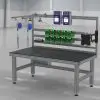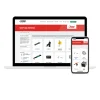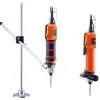The options at your disposal for preset and adjustable torque wrenches are many.
Picking the correct size and shape for your application is a rather straight forward process which we will not be diving into in this post, but if you have any additional questions, please reach out to us at [email protected].
Today we’re going to focus exclusively on the three main primary indicators which alert the user of a digital or manual torque wrench that they’ve achieved their desired level of torque.
So, let’s jump right into some of the finer details of those three primary indicators: Click, Break & Slip.
Click
The most widely known, and used, form of torque wrench in use – the click torque wrench.
Upon reaching target torque these wrenches alert the operator in two very distinctive and unmistakable ways. The first is the audible click while the second is the feeling of the click which signals that fastener’s completed sequence. Having two ways of alerting the operators to stop pulling the moment the click is heard or felt is of particular importance.
As pressure is released the tool automatically resets and can immediately be used on the next fastener.
With multiple target torque indicators, combined with the efficiency of not having to manually reset the tool, it is very clear why click wrenches have carved out such an impressive market share.
Break
While click wrenches offer the benefit of multiple indicators, there are certainly special use cases in which limiting the amount of torque placed on a fastening application is necessary.
A breaking torque wrench could prove to be the go-to tool for those with highly specific torque targets. Most breaking torque wrenches break at the fulcrum, usually at the tool’s head, upon reaching the preset torque value for the application.
Having the tool break at that specific point gives more of a safeguard against overtightening, but that said, if the operator continues to apply force, torque will in turn be applied above the torque limit.
Slip
The slipping or “cam-over” style torque wrench essentially eliminates the ability of an operator to continue placing torque on a fastener after reaching target torque.
Like the breaking torque wrench, a slipping torque wrench will cam over once target torque is achieved, but if the operator continues to apply force it will not result in torque being applied above the set limit.
Completely eliminating the possibility of over-torque on the fastener makes slipping torque wrenches perfect for applications which require extremely stringent quality guidelines. These instances could include everything from military or medical applications to consumer goods where safety is paramount.
The easiest way to ensure those guidelines are being followed was to create a wrench which takes any possibility of operator error out of the equation to produce accurate and repeatable results.
Want to Learn More?
For more insight on these mechanisms, this video from our partners at Gedore can provide a more visual representation of the information we’ve just covered.
Ready to make a torque wrench purchase?
See our full line of torque wrenches or go ahead and look directly at our line of Gedore products.







